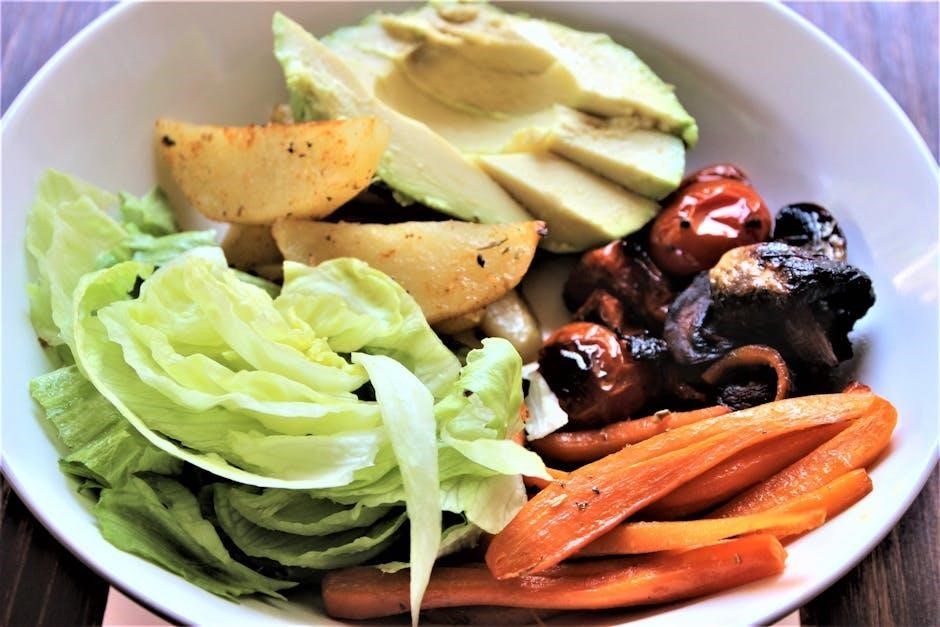
Ready meals have surged in popularity, offering convenience for modern lifestyles. These pre-prepared dishes come as frozen, ready-to-cook, or ready-to-heat options, appealing to busy individuals seeking quick, tasty, and nutritious solutions.
1.1 The Rise of Convenience Foods in Modern Lifestyle
Modern lifestyles, marked by busy schedules and urbanization, have fueled the demand for convenience foods. Ready meals offer a practical solution for individuals seeking quick, affordable, and varied dining options without compromising on quality. The rise of ready-to-cook and ready-to-heat meals aligns with the growing need for efficiency, catering to professionals, families, and students alike. This trend reflects a societal shift toward prioritizing time and accessibility in daily routines.
1.2 Definition and Types of Ready-to-Cook Meals
Ready-to-cook meals are pre-prepared dishes requiring minimal effort to prepare at home. They come in various forms, including frozen meals, such as shrimp with cocktail sauce, and oven-cook-only options. These meals are designed to simplify cooking while offering diverse flavors and dietary preferences. Examples include ready-to-heat dishes like cooked shrimp and imitation crab, catering to different tastes and busy lifestyles. They provide a convenient solution for home cooking without sacrificing variety or quality.
Benefits of Using Ready-to-Cook Meals
Ready-to-cook meals save time, offering accessible, quick solutions for busy lifestyles. They provide balanced nutrition and cater to diverse dietary needs, making meal preparation efficient and stress-free.
2.1 Time-Saving and Accessibility
Ready-to-cook meals significantly reduce preparation time, offering quick solutions for busy individuals. With options like microwave and oven instructions, they cater to various dietary needs and preferences, making mealtime efficient and accessible. These meals are ideal for those with limited cooking skills or tight schedules, ensuring a fast and convenient way to enjoy balanced nutrition without compromising on taste or quality.
2.2 Nutritional Value and Health Considerations
Ready-to-cook meals offer balanced nutrition, catering to diverse dietary needs. Many options are rich in essential nutrients, with plant-based and organic choices gaining popularity. However, some meals may contain higher sodium levels, so checking labels is crucial. While not as ideal as homemade dishes, ready meals provide a convenient and healthy alternative for those with limited cooking time or skills, supporting overall well-being when chosen mindfully;
Instructions for Cooking Ready Meals
Always follow package instructions for cooking times and methods. Check labels for specific guidance, such as microwave, oven, or stovetop preparation. Use a food thermometer to ensure proper internal temperatures, and let meals rest briefly before serving for even heating and safety.
3.1 Microwave Cooking Guidelines
For microwave cooking, follow package instructions for precise times. Most ready meals cook in 8-12 minutes. Pierce film, cook on high, and stir if needed; Check internal temperature reaches 165°F. Let stand for 1-2 minutes to ensure even heating. Avoid overheating, as it can dry out the meal. Always use a microwave-safe container for safety and optimal results. Adjust cooking time based on microwave wattage for best outcomes.
3.2 Oven Cooking Instructions
Preheat the oven to 350°F (175°C) for most ready meals. Place the meal on a baking tray, removing any packaging. Cook for 35-40 minutes, or as per instructions. Ensure the internal temperature reaches 165°F (75°C) for safety. Let the meal rest for 2-3 minutes before serving. For best results, avoid overcrowding the oven and use oven-safe containers. Always check the package for specific cooking times and temperatures to ensure optimal flavor and texture.
3.3 Stovetop and Alternative Methods
For stovetop cooking, heat a skillet over medium heat and add a small amount of oil or butter. Pour in the meal, stirring occasionally, and cook until heated through, about 8-12 minutes. Ensure the internal temperature reaches 165°F (75°C). Alternative methods include air frying or grilling for crispy textures. Follow package instructions for specific guidance, and adjust cooking times based on meal type and serving size for optimal results.

Safety Tips for Preparing Ready Meals
Always follow package instructions for safe preparation. Properly handle and store meals, ensuring they are cooked to the recommended internal temperature. Never leave cooking unattended.
4.1 Proper Handling and Storage
Proper handling and storage are crucial for maintaining the quality and safety of ready meals. Always store frozen meals at 0°F (-18°C) or below and refrigerated meals at 40°F (4°C) or below. Ensure meals are sealed in their original packaging to prevent contamination. Check expiration dates before consumption. Thaw frozen meals in the refrigerator or microwave, never at room temperature. Wash hands before handling and keep raw foods separate from ready-to-cook meals to avoid cross-contamination. After cooking, cool the meal to room temperature within two hours and refrigerate promptly to prevent bacterial growth. Always follow package instructions for specific storage guidelines to ensure food safety and freshness. Proper storage helps retain nutritional value and flavor, making your ready meals enjoyable and safe to eat.
4.2 Avoiding Common Mistakes
Avoiding common mistakes when preparing ready meals is essential for safety and quality. Overcooking can lead to dry, tasteless food, while undercooking may pose health risks. Always follow package instructions for cooking times and temperatures. Neglecting to stir or flip food during cooking can result in uneven heating. Never reuse cooking utensils without washing to prevent cross-contamination. Ensure meals reach a safe internal temperature, typically 165°F, to avoid foodborne illness. Properly vent microwaves to prevent moisture buildup. Avoid overcrowding cooking vessels, as this can affect even heating. Check meals halfway through cooking to adjust as needed. By avoiding these mistakes, you can enjoy a safe and satisfying dining experience.

Cost-Effectiveness of Ready Meals
Ready meals can be cost-effective, offering convenience at affordable prices. While they may seem cheap, homemade alternatives are often more economical. Budget-friendly options like bulk purchases or coupons can enhance savings, making ready meals a practical choice for many households without compromising on quality or taste.
5.1 Comparison with Homemade Meals
Ready meals are often compared to homemade meals in terms of cost and convenience. While ready meals save time, studies show that cooking at home can be more economical. Homemade meals allow for portion control and the use of fresh, healthier ingredients, potentially reducing long-term costs. However, ready meals remain a practical option for busy individuals, offering a quick solution without sacrificing taste, even if slightly more expensive than homemade alternatives.
5.2 Budget-Friendly Options
Ready meals offer affordable solutions for budget-conscious consumers. Many brands provide discounted bulk purchases or value packs, making them cost-effective. Additionally, meal delivery services often include budget-friendly options, catering to various price points. These alternatives are frequently cheaper than dining out, offering a practical compromise between convenience and affordability. With options like frozen meals and simple heat-and-serve dishes, ready meals can fit into tight budgets while still providing satisfying meals.
Environmental Impact of Ready Meals
Ready meals contribute to environmental concerns due to packaging waste and energy use. A study revealed oven cooking ready meals increases carbon emissions by up to 20%. Eco-friendly alternatives are emerging to address these issues and promote sustainability in the ready meal industry.
6.1 Packaging and Waste Concerns
Ready meals often come in single-use plastics and non-recyclable materials, contributing significantly to landfill waste and environmental pollution. The packaging, designed for convenience, frequently includes multiple layers of plastic, foil, and cardboard, which are challenging to recycle. This excessive packaging not only harms ecosystems but also intensifies the global plastic crisis. As consumer awareness grows, companies are pressed to adopt sustainable packaging solutions to reduce waste and minimize environmental harm.
6.2 Eco-Friendly Alternatives
Eco-conscious brands are shifting toward sustainable packaging, such as biodegradable materials and recyclable containers, to reduce waste. Plant-based ready meals with minimal packaging are gaining traction, offering healthier and environmentally friendly options. Companies are also adopting compostable wrapping and reducing plastic use, aligning with consumer demands for greener alternatives. These changes aim to lower the environmental impact while maintaining meal convenience and quality.
Trends in the Ready Meal Market
The ready meal market is evolving with rising demand for plant-based, organic, and sustainable options. Innovations in meal delivery services and healthier formulations are driving growth.
7.1 Growth of Plant-Based and Organic Options
Plant-based and organic ready meals are gaining popularity due to increasing health awareness and environmental concerns. Consumers are seeking cleaner, sustainable ingredients, driving demand for eco-friendly products. Plant-based meals, often lower in saturated fats and higher in nutrients, cater to dietary preferences. Organic options ensure no artificial additives, aligning with wellness trends. This shift reflects broader consumer priorities toward healthier, more sustainable living, influencing the ready meal market’s innovation.
7.2 Innovations in Meal Delivery Services
Meal delivery services are revolutionizing the ready meal industry with chef-prepared, plant-based, and organic options. Many services now offer flexible subscriptions, customizable menus, and eco-friendly packaging. Innovations like app-based ordering and real-time tracking enhance convenience. These services cater to diverse dietary needs, ensuring high-quality, nutritious meals reach consumers effortlessly. The integration of technology and sustainability is driving the growth of this sector, making it a key player in the future of ready-to-cook meals.

Tips for Choosing the Best Ready Meals
Reading labels ensures nutritional balance and quality ingredients. Customize meals to suit taste preferences and dietary needs, prioritizing fresh and wholesome components for optimal satisfaction.
8.1 Reading Labels and Ingredients
Examine nutritional labels to ensure meals align with dietary needs. Check sodium, protein, and saturated fat levels. Opt for options with wholesome ingredients and minimal preservatives. Prioritize meals with fresh components and avoid excessive additives. Look for certifications like “low-sodium” or “organic” if preferred. Reading labels helps make informed choices, ensuring the meal is both nutritious and satisfying. This step is crucial for maintaining health and flavor preferences. Always verify allergen information for safety.
8.2 Customizing Meals for Personal Preferences
Customizing ready meals allows for personalization to suit tastes and dietary needs. Add fresh herbs, spices, or sides for extra flavor. Substitute ingredients to accommodate preferences or allergies. For health-conscious options, reduce sodium by omitting added salts or enhance protein content. Customize portion sizes for individual needs. These tweaks ensure meals remain satisfying while aligning with personal preferences and nutritional goals, making ready meals versatile and adaptable to various lifestyles and requirements.

Popular Ready Meal Brands
Leading brands like Cook and ReadyMeals offer high-quality, convenient options. These brands are known for their flavor, variety, and commitment to using fresh ingredients, catering to diverse tastes and preferences.
9.1 Overview of Leading Market Players
Leading ready meal brands like Cook and ReadyMeals dominate the market, offering diverse options. Cook, known for its high-quality dishes, has navigated challenges like the 2008 financial crisis, while ReadyMeals provides convenient seafood options. These brands emphasize quality, flavor, and customer satisfaction, catering to evolving consumer preferences and dietary needs. Their commitment to innovation and taste keeps them at the forefront of the ready meal industry.
9.2 Consumer Reviews and Ratings
Consumer reviews highlight the quality and flavor of ready meals, with brands like Cook and ReadyMeals receiving praise. Many appreciate the convenience and taste, though some note higher costs. Plant-based options are increasingly popular, aligning with health trends. Overall, ready meals are well-received, offering a balance of comfort and nutrition, with brands continuously adapting to meet diverse consumer preferences and dietary needs.
Ready meals offer a convenient solution for modern lifestyles, balancing taste, nutrition, and time efficiency. As demand grows, the market continues to evolve, promising healthier and eco-friendly options.
10.1 Balancing Convenience and Health
While ready meals offer unmatched convenience, balancing health requires careful consideration. Opt for options with wholesome ingredients and moderate sodium levels. A study revealed that homemade meals can be equally affordable and nutritious, but ready meals are evolving to include healthier choices. Always check labels for nutritional content and aim for meals rich in protein and vegetables. Prioritizing quality ensures you enjoy both convenience and wellness.
10.2 Future of Ready-to-Cook Meals
The future of ready-to-cook meals looks promising, with growing demand for convenience and health. Innovations in packaging and delivery services are expected to rise, catering to eco-conscious consumers. Plant-based and organic options will dominate, offering sustainable solutions. As technology advances, customizable meals may emerge, blending nutrition with personal preferences. The market is poised for growth, driven by evolving lifestyles and a focus on quality ingredients.